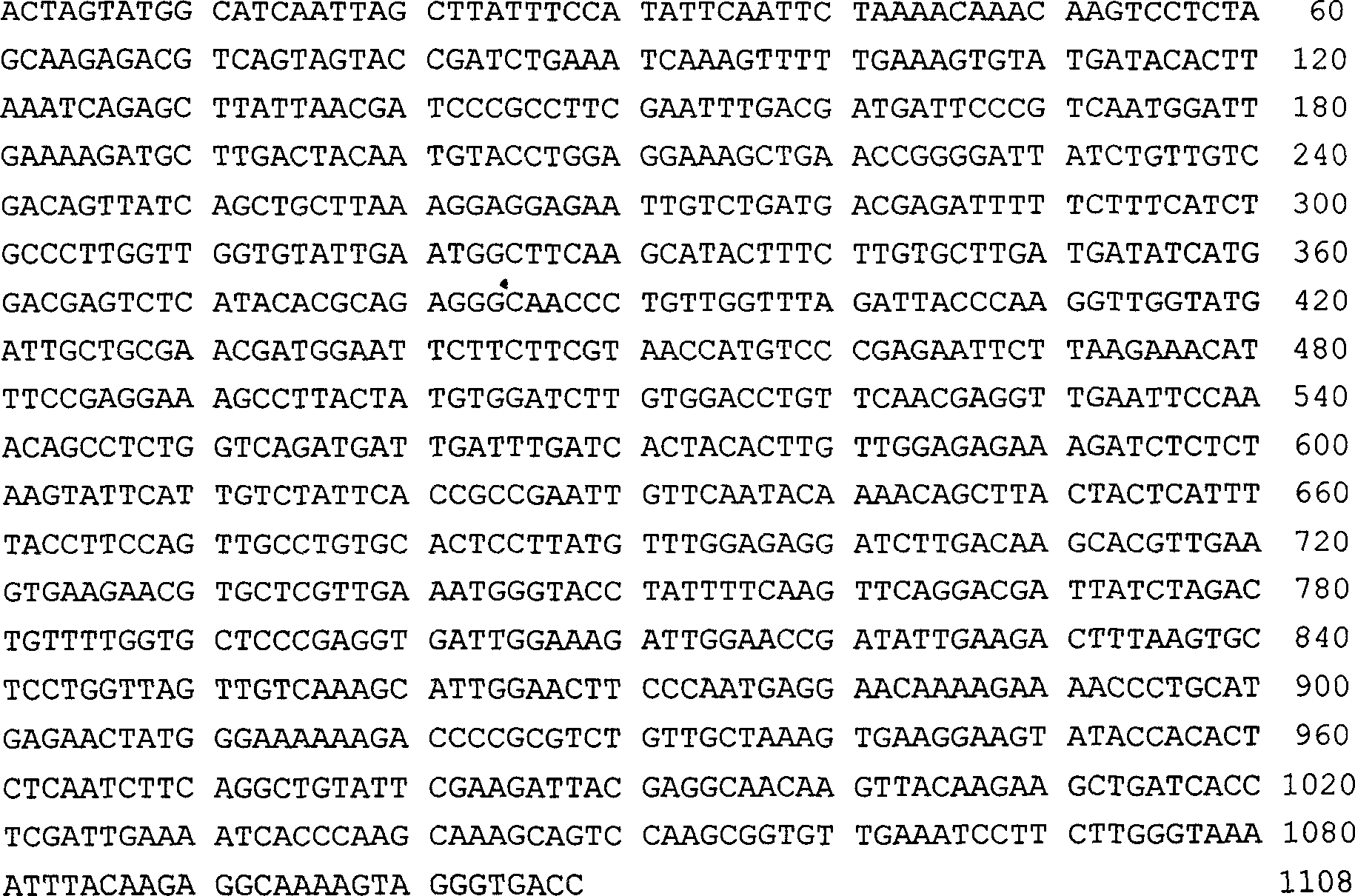Farnesyl pyrophosphoric acid synthetase fusion gene carrying plastid transport peptide and application thereof
A technology of farnesyl pyrophosphate and fusion gene, which is applied in the field of plant genetic engineering, can solve the problems that artemisinin has not been reported, and achieve the effect of increasing the content and activity of artemisinin
- Summary
- Abstract
- Description
- Claims
- Application Information
AI Technical Summary
Problems solved by technology
Method used
Image
Examples
Embodiment 1
[0029] Example 1: Cloning of the transit peptide lstp of Artemisia annua linalool synthase
[0030] Using the total RNA of Artemisia annua as a template, the 72bp lstp was amplified by RT-PCT method, and the amplified product was recovered and cloned by TA.
[0031] (1) RT-PCR amplification of the target fragment
[0032] Specific primers were designed according to the nucleotide sequence of the transit peptide of Artemisia annua linalool synthase published in GenBank, the Spe I restriction site was introduced into the upstream primer, and the Aat II restriction site was introduced into the downstream primer.
[0033] Upstream primer: 5'-cccactagtatggcatcaattagcttatttcc-3'
[0034] Downstream primer: 5'-cccgacgtctcttgctagaggacttg-3'
[0035]Extract the total RNA of Artemisia annua (the RNA extraction kit of Shanghai Huashun Biological Engineering Co., Ltd.), use RNA as a template, reverse transcribe into cDNA (TaKaRa RNA PCR 3.0Kit), use the above primers to carry out PCR am...
Embodiment 2
[0039] Embodiment 2: Artemisia annua farnesyl pyrophosphate synthase gene fps clone
[0040] Design specific primers according to GenBank published cDNA sequence information of Artemisia annua fps gene (GenBank accession number: AF112881), introduce Aat II restriction site at the 5' end, and remove the initiation codon ATG of the fps coding region, downstream The primers introduce the Bste II restriction site. The size of the PCR product should be 1042bp.
[0041] Upstream primer: 5'-cccgacgtcagtagtaccgatctgaaa-3'
[0042] Downstream primer: 5'-cccggtgaccctacttttgcctcttgtaaa-3'
[0043] Extract the total RNA of Artemisia annua (the RNA extraction kit of Shanghai Huashun Biological Engineering Co., Ltd.), use RNA as a template, reverse transcribe into cDNA (TaKaRa RNA PCR 3.0Kit), use the above primers to carry out PCR amplification with cDNA as a template, Prepare fps fragments. TA cloning was then performed. The PCR reaction conditions were 94°C for 3 minutes, followed b...
Embodiment 3
[0044] Embodiment 3: utilize pCAMBIA1304 vector to construct lstp-fps fusion gene
[0045] The vector plasmid pCAMBIA1304 was extracted from Escherichia coli, and the large vector fragment was recovered by double enzyme digestion with Spe I / Bste II.
[0046] The plasmid was extracted from the TA clone prepared in Example 1, digested with Aat II / Spe I, and the lstp fragment was recovered by agarose gel electrophoresis.
[0047] The plasmid was extracted from the TA clone prepared in Example 2, digested with Aat II / Bste II, and the fps fragment was recovered by agarose gel electrophoresis.
[0048] The above three fragments were ligated overnight at 16° C. under the catalysis of ligase to complete the construction of the lstp-fps fusion gene on the pCAMBIA1304 vector. The connection system is: T4 DNALigase 1ul, T4 DNALigase Buffer 1ul, pCAMBIA1304 vector recovery fragment 5ul, lstp recovery fragment 1.5ul, fps recovery fragment 1.5ul. The ligation mixture was transformed into ...
PUM
 Login to View More
Login to View More Abstract
Description
Claims
Application Information
 Login to View More
Login to View More - R&D
- Intellectual Property
- Life Sciences
- Materials
- Tech Scout
- Unparalleled Data Quality
- Higher Quality Content
- 60% Fewer Hallucinations
Browse by: Latest US Patents, China's latest patents, Technical Efficacy Thesaurus, Application Domain, Technology Topic, Popular Technical Reports.
© 2025 PatSnap. All rights reserved.Legal|Privacy policy|Modern Slavery Act Transparency Statement|Sitemap|About US| Contact US: help@patsnap.com

